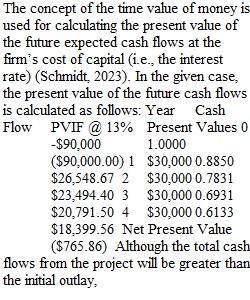


Q There are two written assignments due this week. Unit 9 Assignment 1: In this assignment, you will be assessed based on the following Course Outcome: MT480-4: Assess investment options based upon cost of capital and expected returns. Read the scenario and address all of the checklist items. Scenario: A new product manager presents to you, the chief financial officer, a proposal to expand operations that includes the purchase of a new machine. The product manager is certain that the positive cash flows, which exceed the initial outlay by $30,000 by the end of Year 4, will bring both praise and approval. You explain the company uses a 13% discount rate for cash flows and project-related budgeting. You take the time to present the details of the net present value (NPV) model used to assess product proposals. The data is below. Project Outflows to Buy Machine Day 1 Cash Out -$90,000 13% discount rate applied. End Year 1 Cash Repayment $30,000 End Year 2 Cash Repayment $30,000 End Year 3 Cash Repayment $30,000 End Year 4 Cash Repayment $30,000 To educate the new manager, and as CFO, you take the time to evaluate the following: Checklist: • Evaluate how the Time Value of Money concept results in a discounted cash flow in year 4 (an amount less than $30,000). • Assess the investment option using a 13% cost of capital discount rate by applying the NPV model. Include values in your assessment. Provide the NPV at a 13% cost of capital discount rate. Include values in your assessment. • Assess the investment option with an 8% cost of capital discount rate. Directions for Submitting Your Assignment Submit a 2–3-page paper with an additional title page in APA format. Please label your assignment as “Unit 9 Assignment 1— your name” and submit it to the Unit 9 Assignment 1 Dropbox.
View Related Questions